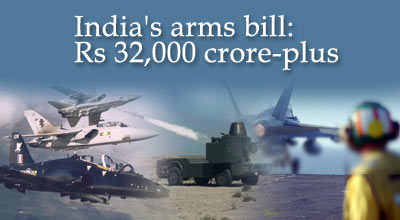Home > Business > Special
Rahul Bedi |
September 24, 2003

India could be emerging as a major market for armaments over the next few years with the BJP-led government negotiating or finalising deals worth well over $7 billion -- Rs 32,000 crore at today's conversion rate of Rs 45.7/$ -- for a variety of military hardware to replace obsolescent Soviet military equipment.
The deals include the recent decision to complete the planned acquisition of 66 Hawk jet trainers for $1.7 billion (Rs 7,769 crore) and negotiations for the purchase of 126 Mirage 2005 fighter aircraft to enhance strike and nuclear deterrence capabilities in a deal worth over $4.4 billion (Rs 20,108 crore).
Talks have also begun with Israel for the $1 billion (Rs 4,570 crore) Phalcon early warning system.
The IAF is also negotiating expensive mid-life upgrades for its MiG 27M and MiG 29 strike aircraft navigation/attack system and the ageing Jaguar fleet with Israel and Russia.
Israel's ELTA, which is owned by Israel Aircraft Industries, is also likely to be involved in upgrading the avionics suite of the Navy's Russian Kamov 25 helicopters and Dornier fleet. The size of these deals is not yet known.
This level of expenditure could see a substantial jump in the defence ministry's expenditure from the 2003-04 Budget estimates of roughly $4.5 billion (Rs 20,565 crore).
It could also mark a reversal of the trend of the past three years, when the ministry returned more than $3.8 billion (Rs 17,366 crore) to the exchequer.
Since the late 1990s the Indian Air Force has signed contracts with foreign vendors for well over $6 billion (Rs 27,420 crore).
In 1996 it bought 40 Su 30 MKI series multi-role fighters for $1.8 billion (Rs 8,226 crore), agreed to acquire 10 more two years later for an undisclosed amount and signed a $3 billion (Rs 13,710 crore) contract in January 2001 for the licensed production of 140 of these front-line combat aircraft.
Hindustan Aeronautics Ltd has begun upgrading 125 MiG 21 "BIS" fighters, which the delayed Light Combat Aircraft -- also dependent on the General Electric F 404-GE-F2J3 power plant, imported avionics and a variety of overseas systems -- the locally designed aircraft was meant to replace.
Besides Russian involvement, the MiG 21 upgrade involves French and Israeli vendors in the retrofit programme valued at over $700 million (Rs 3,200).
Another $328 million (Rs 1,500) has been sanctioned to buy an additional ten 2000 H fighter aircraft in service with the IAF from Dassault Aviation of France, deliveries of which are to be completed by 2004 to replace those lost in accidents and to maintain war wastage reserves.
The surge in imports follows a recognition that the government's declared aim of becoming 70 per cent self-sufficient in defence R&D and equipment by 2005 is unlikely to be attained.
All attempts by the Defence Research and Development Organisation, 39 ordnance factories and eight defence public sector units to achieve this have failed.
Consequently, countries like Russia, Israel, Britain, France and, to a lesser extent, South Africa continue tapping into India's poverty to enrich themselves.
During his recent visit, Israeli Deputy Prime Minister Yosef Lapid indicated that Israel, which has become the second largest supplier of military equipment to India after Russia, was also keen on selling New Delhi the hugely expensive Arrow II anti-ballistic missile defence system, but needed Washington's approval as the US was a collaborator in the project.
India has already acquired two Israeli Green Pine radar, capable of tracking missiles at a distance of 400 km, which are normally used in conjunction with the Arrow II anti-missile system for an unspecified amount.
Part II: India prefers the Russian arms bazaar
Powered by 